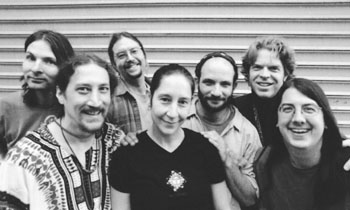![[Metroactive Music]](/music/gifs/music468.gif)
[ Music Index | Santa Cruz Week | SantaCruz Home | Archives ]
The Music Never Stops
Tribute band Dark Star Orchestra gives Deadheads a reason to live
By Scott Cooper
Don't be surprised at the sight of an abundance of peanut-butter-and-tofu burritos being hawked in front of the Cocoanut Grove Friday night. The Dark Star Orchestra is coming to town, and like the Grateful Dead shows they re-create, the scene outside the venue is often just as cultural as the one inside.
"It's pretty funny," says DSO keyboard player Scott Larned. "We see little things that do happen like that. All of a sudden there'll be a big vending scene. Stuff that makes you really feel like you're back in the day."
By "in the day," Larned means any day between 1972 and 1995, the range of dates to which DSO refers when picking a particular Grateful Dead show to perform in its entirety. "We haven't gone past the '70s," Larned adds. "It was a totally different sound than what they had from '72 on, pretty much. At some point when we have some vacation time, we'll sit down and really get into the old sound and learn all the different arrangements, but for now what we know is '70s, '80s and '90s."
Like the Dead, who never repeated a set list, DSO also never repeats a show. "We try to string them together so that we don't do a lot of repeats, regardless of the era. So if we play a few shows in a row and people are sort of on tour and they see three shows in a row, we don't play the same song each night. Actually, because of what we do, doing that's OK because if you see a 'Tennessee Jed' from '73 and then a '79 one and then a '92 one, they're all going to be pretty different anyway. So we try to shake it up in terms of the set list."
However, certain issues arise when a band tries to capture the unique sounds and styles of a band that did not always have the same personnel over its 30-year existence. When DSO performs a set from the '70s, singer Lisa Mackey covers Donna Godchaux's wailing harmonies, but when they perform a show from the '80s or '90s, she takes the night off.
Similarly, when the band covers a show from '72-'74, during which time drummer Mickey Hart took a sabbatical from the Dead and Billy Kreutzmann played alone, DSO dresses only one of its two drummers (Rob Koritz and Dino English). "We fudge a little bit there when we do the early '70s stuff," says Larned. "Those guys rotate. Rob, who does the Mickey stuff, was not feeling like it would be really fair for him to sit out for half a tour if we did a bunch of '73 shows. So they came up with the idea that they could both switch. That's actually really cool because it enables them to both launch into a study on Billy's solo drumming. It's cool. They really get into critiquing each other when they're doing it."
Regardless of what year the band is depicting, Larned stays onstage. However, since the Grateful Dead had three different keyboard players from '72 onward, Larned has to assume different roles and personalities, and use different equipment. "The reason that I play music pretty much is because of ['80s keyboard player] Brent [Mydland]. Brent was my huge idol and influence. The majority of Dead shows I saw were in the '80s, so naturally I just gravitated toward him because he was what I got to see. He had all those sounds like the Hammond organ. Wow, a beautiful sound. Nothing like it. We were real '80s heavy in the beginning. I had never done any singing in a band before either. I started singing the Brent tunes, and I guess since I never sang like anybody else, it came easy."
By contrast, bassist Kevin Rosen, lead guitarist John Kadleck and rhythm guitarist Rob Eaton only have to mimic one person each. While all three have an uncanny ability to re-create the sound of their counterpart in the Dead, only Eaton--who also happens to be Pat Metheny's studio engineer--has Bob Weir's subtle nuances and body movements down so pat that it's scary.
Almost as scary as a peanut-butter-and-tofu burrito.
Copyright © Metro Publishing Inc. Maintained by Boulevards New Media.
![]()

Still Truckin': Members of Dark Star Orchestra conjure up the spirit of the Grateful Dead.
From the April 10-17, 2002 issue of Metro Santa Cruz.